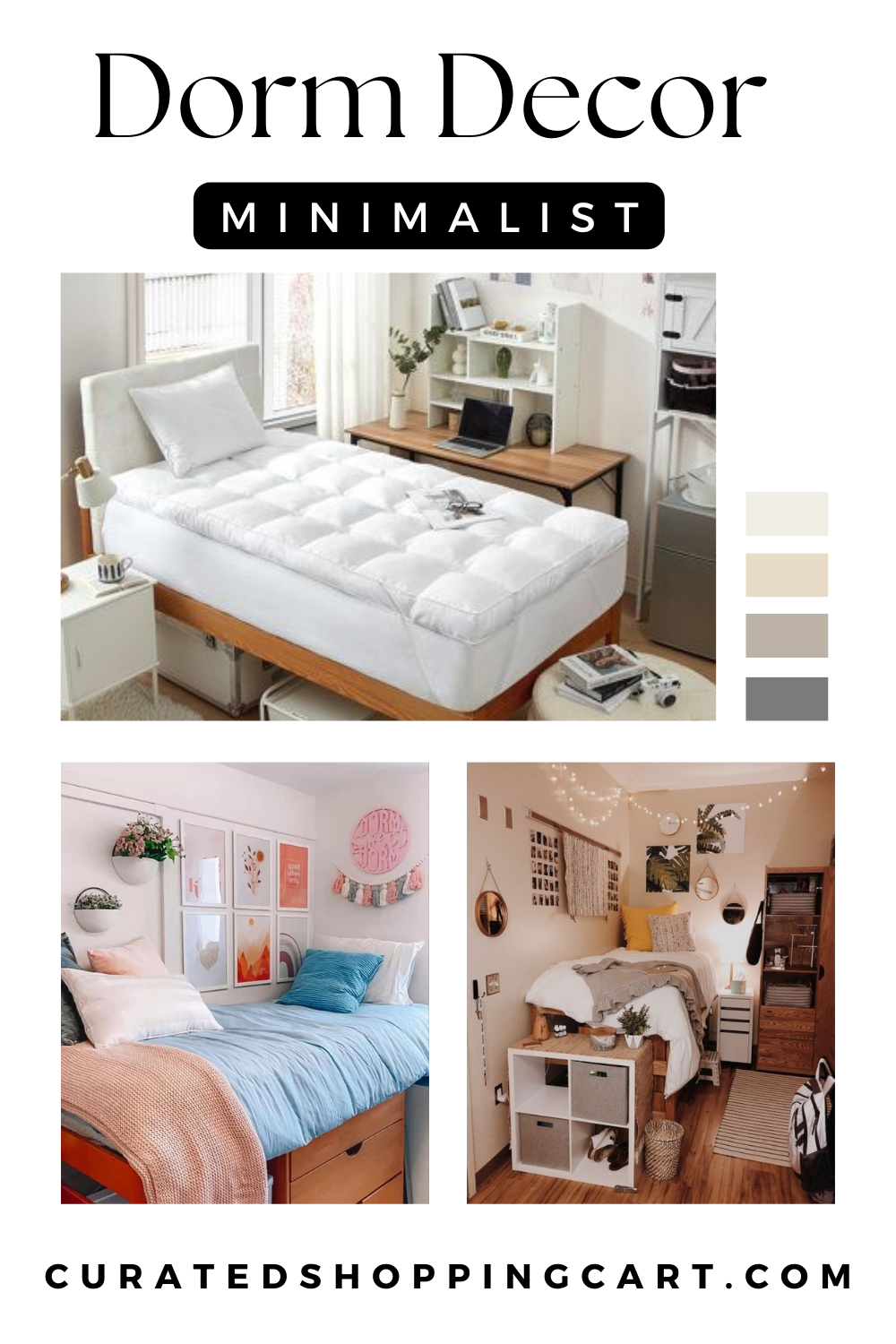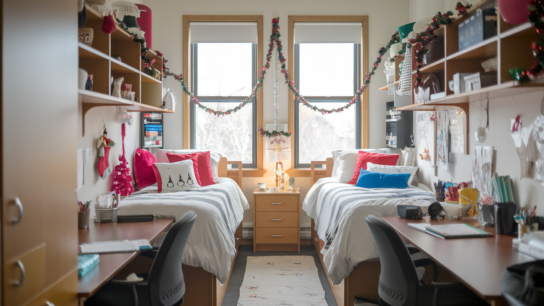Starting college is exciting…a new phase in life and living in a dorm? Oh yes! It’s your perfect chance to create a cozy, functional, and aesthetically pleasing space that reflects your personality while also accommodating your busy student life.
All that is great but dealing with those tiny dorm rooms? Yeah, Not so much. Those cramped quarters can leave you feeling claustrophobic before you even unpack.
But you don’t need to stress – with smart minimalist decorating, you can transform that room into a stylish, functional space without it feeling cramped or cluttered.
The Problem With Clutter
Dorm rooms are typically under 200 square feet, which doesn’t leave much space once you add in all the essentials like a bed, desk, dresser, and maybe a mini fridge. Cramming too much furniture and stuff into that small footprint results in a cluttered, jam-packed cave instead of an inspiring living space.
Why Minimalism Works
Minimalist design keeps things simple and clutter-free by only including the most essential, functional pieces.
Sticking to a tight edit of furniture, accessories, and personal belongings instantly opens up the room. And by limiting the amount of “stuff,” you’ll create a relaxing atmosphere – no more feeling overwhelmed by towering piles of junk!
So, here’s a step-by-step guide to achieving a minimalist dorm room:
1. Declutter Ruthlessly
Before you start decorating, declutter. This is the essence of minimalism. Bring only what you truly need and love. Ask yourself if each item is necessary or if it adds value to your space.
2. Choose a Neutral Color Palette
One of the biggest mistakes you can make in a small room is to go overboard with bold colors. Bright, overpowering hues tend to close in the space and make it feel cramped.
Instead, stick to a primarily neutral palette of whites, grays, tans, and blacks. Shades of beige and soft pastels also work well. These colors help create an open, airy feel while giving a cohesive look. Use your bedding, removable furniture covers, curtains, rugs, and accessories to layer in calming neutrals.
You can always add pops of color with easily changeable pieces like pillows, wall art, or an accent chair or pouf or even just a cozy throw. But overall, the room should remain a blank, neutral canvas.
3. Multi-functional Furniture
In a dorm room, space is at a premium. Trying to cram too many furniture pieces into a dorm room is a one-way ticket to Crampville. Stick to only the most essential, functional items. A standard dorm might include:
- A loft bed or captain’s bed with storage
- A small couch, futon or comfy chair
- A compact dresser or wardrobe unit
- A petite desk and chair
Whenever possible, invest in multipurpose items that serve more than one function. An ottoman can provide storage and be used as a coffee table. A tall bookcase can house books plus have open shelving for other items. A daybed or futon works for seating and sleeping.
A bed with storage drawers underneath, a desk that doubles as a vanity, or a foldable chair that can be tucked away when not in use are all great options.
Also, with limited floor space, you’ll need to take your storage up the walls. Vertical storage pieces like shelving units, hanging racks, and over-the-door organizers will be your best friends. Use them to maximize every inch of space and get items up off the floor.
4. Build Around The Bed
In a dorm, the main piece is going to be the bed, so build the rest of your minimalist layout around that. Using a loft bed or raised bed frame creates underbed storage space for stackable bins and trunks. A small bookshelf can double as a nightstand and storage space for your textbooks and supplies.
Alternatively, a captain’s bed has built-in drawers that can hold clothes, linens, and more. Complement it with a simple headboard – maybe one with built-in shelving – to create a cozy nook.
If you can, try to leave some open walking room around the perimeter of the bed to prevent a closed-in feeling. You may need to forgo bedside tables and use wall-mounted reading lamps instead.
5. Quality over Quantity
Invest in a few high-quality pieces rather than a lot of cheap items. A sturdy desk chair, a comfortable mattress topper, and durable bedding can make a big difference in your daily comfort and the longevity of your decor.
6. Clutter Control
The biggest challenge of minimalist design? Keeping clutter from creeping back in! Make it a habit to regularly edit out any non-essentials. Use sleek, streamlined storage containers to corral those lingering piles. Stash away off-season clothes and items you won’t need for a while.
Embrace open, negative space as much as possible – it helps create a sense of breathing room. Keep the floor space clear by only having a few floor pieces like a low bed frame and maybe one small surface like a side table (preferably use a small bookshelf that can also be used as a nightstand).
7. Embrace Natural Light
Natural light can make a small space feel larger and more inviting. If possible, avoid heavy curtains and opt for light, sheer ones instead. A mirror can also help reflect light and make the room feel more spacious.
8. Personalize with Care
While minimalism is about simplicity, your space should still reflect your personality. Choose a few personal items, like photos, a favorite book, or a meaningful souvenir, to display. Just be selective to avoid clutter.
9. Greenery
A touch of nature can enhance any minimalist space. A small potted plant or a succulent can add life and freshness to your room without taking up too much space or requiring a lot of maintenance.
You can also add in artificial hanging leaves on one of the walls or a sage green cozy throw over the couch or bed brings that much needed liveliness.
10. Mindful Technology Use
Keep cords and electronics organized and to a minimum. A sleek laptop stand, a wireless mouse, and a charging station can keep your desk area clean and efficient. Hide cords with cable organizers to maintain a tidy look.
11. Stick to Minimalist Decor
When it comes to accessories like lamps, pillows, and wall art, stick to simple designs and clean lines. Avoid busy patterns, bright colors, and tons of knick knacks.
Even a simple wall clock, a couple of framed prints, and a small plant or two can add personality without overwhelming the space. Make sure each item has a purpose or brings you joy.
For a simple cozy lighting at night, you can use neutral or pale colored rice lights to decorate around your bed frame, mirror or your study table.
By focusing on functionality, quality, and simplicity, you can design a space that is not only stylish but also conducive to your academic success and personal well-being.
Quick Shopping List for Minimalist Dorm Decor:
- Neutral bedding set (white or beige)
- Multi-functional desk and chair
- Under-bed storage bins
- Sheer curtains
- Small potted plant or succulent
- Simple wall clock
- Minimalist framed prints or wall art
- Quality mattress topper
- Stackable storage bins
- Over-the-door organizer
Final Thoughts
Overall, creating a minimalist dorm room allows you to maximize every inch while still achieving a stylish, calming living space. With edited furniture, smart storage, and a tight palette of minimalist decor, you’ll be living large in those tiny quarters!
Always remember, your dorm room is your personal retreat amidst the hustle and bustle of college life.
Keep it simple, keep it you, and most importantly, keep it a space where you can thrive.
Happy decorating!







